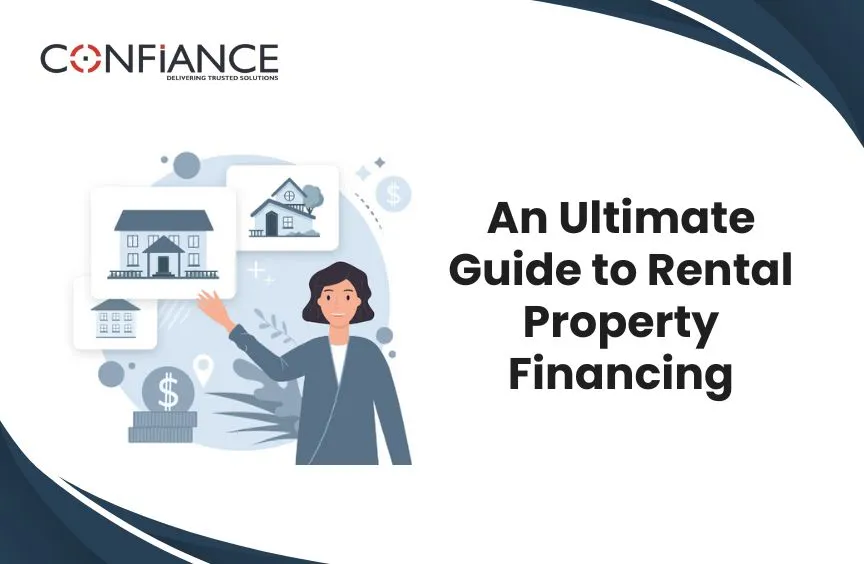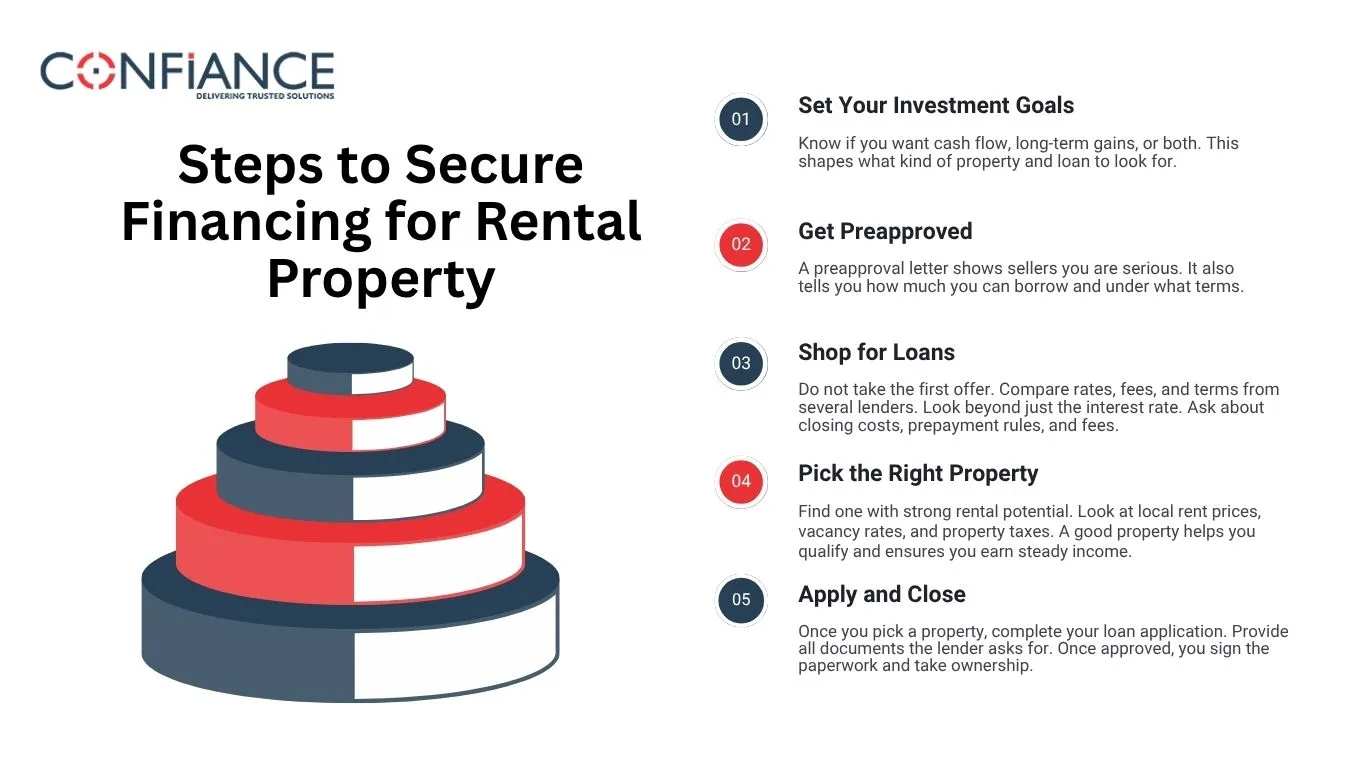
An Ultimate Guide to Rental Property Financing
Buying a rental property can be a smart move, but it usually takes more than just cash in hand. Most investors need some kind of financing. This guide covers the basics, the options, and the steps involved in rental property financing.
What Is Rental Property Financing?
Rental property financing is money borrowed to buy a property that will earn rental income. The property can be a single-family house, a condo, a duplex, or even an apartment building. The goal is to use other people’s money to buy an asset that pays for itself and builds value over time.
Unlike a home loan for your primary house, this type of financing has different rules. Lenders see rental properties as riskier. They often ask for larger down payments and charge higher interest rates.
Why Do You Need Financing for Rental Property?
Most people do not have the full purchase price in cash. Even if they do, using financing lets them keep their cash for other deals or repairs. It also allows them to grow their portfolio faster.
Good financing can boost your return on investment. You use a smaller amount of your own money to control a larger asset. If the rent covers the loan payment and other costs, the property can pay for itself while growing in value.
Types of Rental Properties You Can Finance
Before choosing a loan, you should know what kind of rental property you are buying. Each type affects how you borrow.
Single-Family Homes
These are the easiest to finance. Lenders treat them more like primary homes, especially if you plan to live in one unit and rent the rest.
Multi-Unit Properties
Duplexes, triplexes, and fourplexes fall under this group. They offer more income but can be harder to finance. Loans may require higher credit scores and more money down.
Vacation Rentals
Short-term rental homes in popular travel spots can earn good income. But lenders often treat them like second homes, not rentals. This changes your financing options.
Apartment Buildings
Properties with five or more units fall into the commercial loan category. These loans follow different rules and usually need detailed financials and a strong rental history.
Common Financing Options for Rental Properties
Several loan types are available. The right one depends on your goals, credit, and the property itself.
Conventional Loans
These are the most common. They come from banks or mortgage lenders and follow rules set by Fannie Mae and Freddie Mac. You usually need a 15 to 25 percent down payment, strong credit, and proof of income. Loan terms are often 15 or 30 years.
Portfolio Loans
These loans stay with the lender and are not sold on the secondary market. They offer more flexible terms but may have higher rates. They can work well if you own many properties or do not meet standard loan rules.
Hard Money Loans
These are short-term loans from private investors. They focus more on the property’s value than the borrower’s credit. They come with higher rates and fees but close faster. Investors use them for quick flips or when banks say no.
Commercial Loans
For buildings with five or more units, you need a commercial loan. These loans look at the property’s income more than your personal income. Down payments are often higher, and terms may be shorter.
Home Equity Loans
If you own a home or another rental with equity, you can borrow against it. You can use a home equity loan or a line of credit. These funds can help with the down payment or buy a new rental outright.
Cash-Out Refinance
You can refinance an existing property, take out equity as cash, and use it to buy another rental. This works best when property values are rising.
Seller Financing
Sometimes, the seller agrees to act as the lender. You make payments directly to them. This can help when you cannot qualify for a bank loan or need better terms.
Loan Requirements
Getting a loan for a rental property is not the same as getting one for your own home. Lenders look at several things.
Credit Score
A good score makes it easier to qualify and helps you get lower rates. Many lenders want a score of at least 620 to 640. Better rates usually come with scores over 700.
Down Payment
You will likely need at least 15 to 25 percent down. Lenders want to see you have skin in the game. Some loans may allow less with special programs, but most standard loans will not.
Debt-to-Income Ratio
This measures how much of your income goes toward debt. A lower ratio shows you can handle another loan. Some lenders also consider the rental income from the new property when they calculate this.
Cash Reserves
Lenders may ask you to show several months’ worth of loan payments in savings. This gives them confidence you can pay even if rent stops.
Property Income
For some loans, lenders want proof that the property can make enough to cover the payments. They may ask for rent estimates or leases from current tenants.
How to Prepare for Financing
Getting ready helps speed up the process and improves your odds of approval.
Check Your Credit
Review your score and fix any errors. Pay off small debts and avoid new ones before you apply.
Save for a Down Payment
The more you put down, the lower your monthly cost and the easier it is to qualify.
Gather Documents
You will need tax returns, bank statements, proof of rent, and other paperwork. Start collecting them early.
Know Your Budget
Use a rental income calculator to see what you can afford. Include taxes, insurance, repairs, and vacancies.
Steps to Secure Financing for Rental Property
Follow these steps to find and get a rental property loan.
Step 1: Set Your Investment Goals
Know if you want cash flow, long-term gains, or both. This shapes what kind of property and loan to look for.
Step 2: Get Preapproved
A preapproval letter shows sellers you are serious. It also tells you how much you can borrow and under what terms.
Step 3: Shop for Loans
Do not take the first offer. Compare rates, fees, and terms from several lenders. Look beyond just the interest rate. Ask about closing costs, prepayment rules, and fees.

Step 4: Pick the Right Property
Find one with strong rental potential. Look at local rent prices, vacancy rates, and property taxes. A good property helps you qualify and ensures you earn steady income.
Step 5: Apply and Close
Once you pick a property, complete your loan application. Provide all documents the lender asks for. Once approved, you sign the paperwork and take ownership.
Tips for Getting Better Financing Terms
You can improve your loan offers with a few smart moves.
- Improve your credit score before applying
- Offer a larger down payment
- Show proof of stable rental income
- Use a co-signer if your income is low
- Consider smaller local banks that understand rental markets
- Avoid big financial changes before closing
Risks to Watch For
Every loan comes with risk. Know them before you commit.
Higher Interest Rates
Rental property loans cost more than loans for homes you live in. Shop around and try to get fixed rates to avoid surprises.
Shorter Terms
Some loans must be paid back faster. Make sure the rent can cover the payment.
Market Changes
Rents can drop or homes may lose value. Build a cushion into your numbers so you can still pay the loan.
Tenant Issues
If the property is empty or tenants do not pay, you still owe the loan. Have reserves to cover gaps.
Building a Portfolio Over Time
Start small and build over time. Use the income and equity from your first property to buy the next one. Refinance when rates drop or values go up. Over time, smart financing helps you grow without using all your cash.
There are many ways of financing for rental property, but not all will suit every investor.
Rental property financing does not always remain the same. The right loan depends on your goals, the property, and your finances. Whether you are buying your first rental or adding to a growing portfolio, know your options. Prepare well, borrow wisely, and make sure the numbers work. This way, your property earns income, builds value, and helps grow your long-term wealth. If you want to improve the way you manage your rental properties and its finance, connect with Confiance right away. Our property management bookkeeping has helped many realtors around the world.
FAQs
- Can I get rental property financing with no job?
Yes, but it’s harder. You must show other income sources or strong rental income potential to qualify. - Do banks offer loans for Airbnb or short-term rentals?
Some do, but they may treat it like a second home or require stricter terms. Check lender policies before applying. - How many rental properties can I finance?
Many lenders cap conventional loans at 10 properties. After that, you may need portfolio or commercial loans. - Is LLC ownership better for financing rental property?
Owning through an LLC can protect your assets, but some lenders charge higher rates or limit loan options. - Can I use projected rent to get approved?
Yes, lenders may accept rent estimates from a market analysis or appraiser, even if the property is vacant. - Do I need landlord insurance to get financing?
It’s not always required upfront, but lenders often ask for proof before closing. It protects both you and the lender.
